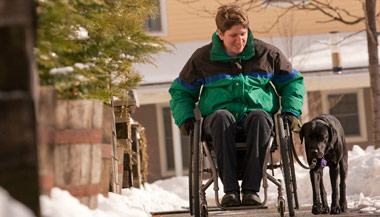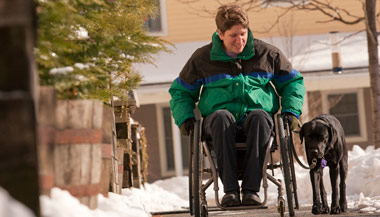Primary Progressive Multiple Sclerosis
What is primary-progressive multiple sclerosis?
Multiple sclerosis (MS) is a neurodegenerative disease. It interferes with your brain's ability to control your body. It can be disabling.
There are 4 main types of MS:
-
Relapsing-remitting MS (RRMS)
-
Primary-progressive MS (PPMS)
-
Secondary-progressive MS (SPMS)
-
Progressive-relapsing MS
Each type might be mild, moderate, or severe. MS affects people differently.
With PPMS, neurologic functions get steadily worse in the beginning. There are no symptom flare-ups (also called relapses or attacks). And there is no recovery (remission). How fast the disease progresses may vary. There can be times when things are stable. And there can be periods of short-term (temporary) minor improvements. But declining neurologic progression is constant.
Men and women are evenly affected by this type of MS. About 10% of people diagnosed with MS have PPMS. On average, people with primary-progressive MS start having symptoms between ages 35 and 39.
What causes primary-progressive MS?
The exact cause of MS is not known, but research suggests it develops when your immune system attacks a substance called myelin. Myelin acts as a type of insulation on your nerve cells. This process can lead to damage in and around the nerves in your brain and spinal cord. It can also damage nerves used for vision.
What are the symptoms of primary-progressive MS?
The occurrence and severity of PPMS symptoms vary with each person. Symptoms can include:
-
Pain (for example, headaches, pain in the legs and feet, back pain, and muscle spasms)
-
Electric-shock sensations that run down the back and limbs when the neck is bent (Lhermitte sign)
-
Trouble walking
-
Vision problems
-
Muscle weakness
-
Trouble staying balanced
-
Paralysis
-
Numbness
-
Prickling feelings
-
Dizziness
-
Shakiness
-
Trouble thinking clearly
-
Mood changes
-
Depression
-
Sexual problems
-
Trouble with bowel and bladder control
How is primary-progressive MS diagnosed?
Methods that your healthcare provider may use to diagnose MS include:
-
Discussion. Your healthcare provider will talk with you about your symptoms.
-
Physical exam. This is done to see how your nerves and muscles are working.
-
MRI scans of your brain and spinal cord. These images will help your healthcare provider look for signs of damage that suggest MS.
-
Optical coherence tomography (OCT). This test measures nerve fibers in the retina.
-
Spinal tap (lumbar puncture). Your healthcare provider removes a sample of spinal fluid to check for signs of MS.
-
Visual evoked potentials (VEP). This test is done to see how well your optic nerves are working.
After the general diagnosis of MS, the diagnosis of PPMS is based almost exclusively on the patient's symptom history. Because of this, it may take time for the PPMS diagnosis to be made.
How is primary-progressive MS treated?
Several medicines are available to treat relapsing forms of MS. But the FDA hasn't approved any medicines to treat primary-progressive MS. Your healthcare provider may still be able to use 1 of these medicines in your case. But more likely your healthcare provider will try to provide treatments that relieve symptoms and improve your quality of life. These may address problems such as depression, sexual problems, and extreme tiredness (fatigue).
How can I prevent primary-progressive MS?
Experts don't know how to prevent MS or the PPMS type of MS. Some people limit MS relapses by avoiding specific triggers such as stress and overheating.
How do I manage primary-progressive MS?
Physical and occupational therapy may be helpful. For example, therapists may teach you exercise strategies and how to manage new symptoms that develop. Your healthcare provider will also probably want to meet with you on a regular basis to monitor your disease.
Regular exercise and getting plenty of sleep may also help. If your body temperature goes up, it may make your symptoms worse for a short time. So it’s best to not do things that could lead to overheating, such as extended periods of time in the sun or overexerting yourself.




